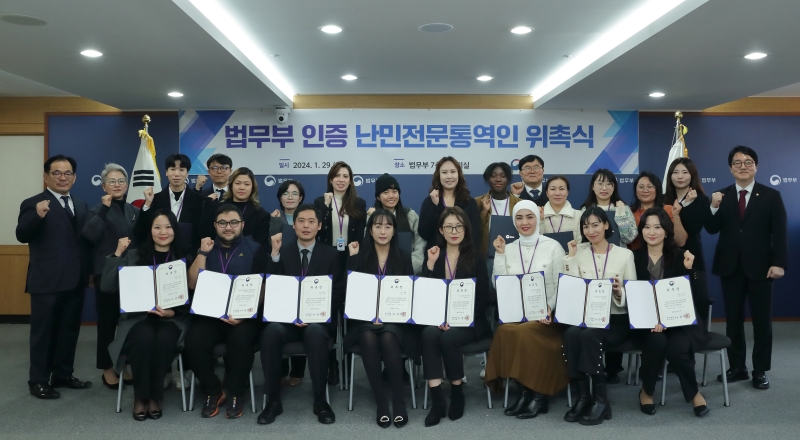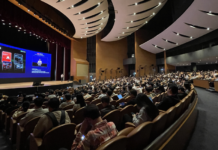
Acting Minister of Justice Shim Woo Jung (right) on Jan. 29 poses for a group photo with newly appointed interpreters for the refugee screening process at their appointment ceremony held at Government Complex-Gwacheon in Gwacheon, Gyeonggi-do Province. (Ministry of Justice)
By Park Hye Ri
The Ministry of Justice has greatly boosted the number of interpreters for the refugee screening process.
The ministry on Jan. 29 said it certified 106 interpreters to assist in communication between asylum seekers and government authorities and gave them letters of appointment.
In 2021, a professional interpreter certification system was launched to help refugee applicants struggling to fully express themselves in Korean. The addition of the 106 staff raised the combined number of such interpreters to 414.
An interpreter for this purpose facilitates communication in interviews between an asylum seeker and officials who screen the former’s application for refugee status. After completing verification of their foreign language skills and the required education for the system, the interpreters act as support staff for such interviews over a three-year period.
By language, 94 interpreters support Chinese, 65 English, 63 Russian, 31 Vietnamese, 20 Mongolian, 15 Arabic, 13 Uzbek and 11 Burmese for a combined 34 languages.
The ministry this year will again run a specialized interpretation system for asylum seekers to upgrade the quality of interpretation for refugee application and hire more specialists in minority languages.
Since last month, a pilot system of video interviews has accommodated asylum seekers who cannot find an interpreter or do a face-to-face interview due to a contagious disease.
Launching the refugee system in 1994, the ministry used to screen applications face to face with candidates only, making it difficult for applicants living in rural areas because of problems in finding an interpreter unlike most applicants, who live in the Seoul metropolitan area. For this reason, the video interview system was adopted with the goal of official operations from April this year.
Asylum seekers can apply for a video interview at eight locations nationwide: immigration offices in Seoul, Incheon, Busan, Daegu, Gwangju, Jeju Island and Incheon International Airport and Government Complex-Gwacheon in Gwacheon, Gyeonggi-do Province.
hrhr@korea.kr























